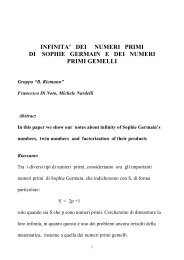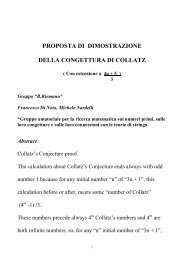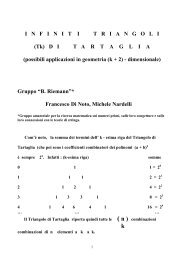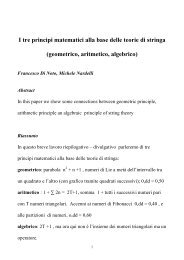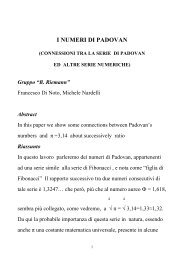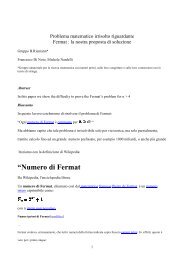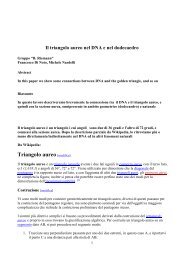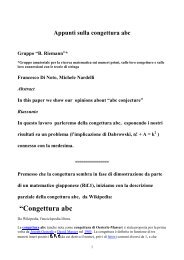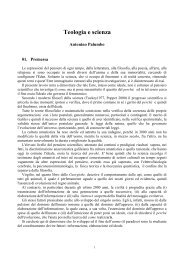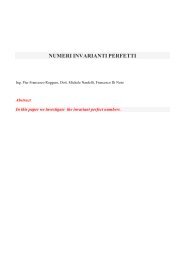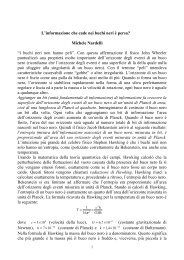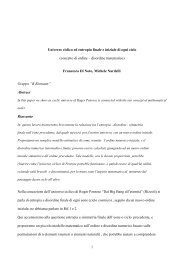proof of fermat-catalan conjecture through the ... - Nardelli - Xoom.it
proof of fermat-catalan conjecture through the ... - Nardelli - Xoom.it
proof of fermat-catalan conjecture through the ... - Nardelli - Xoom.it
You also want an ePaper? Increase the reach of your titles
YUMPU automatically turns print PDFs into web optimized ePapers that Google loves.
Versione 1.022/3/2013Pagina 46 di 4967 prime69 = 3*2371 prime35 =5*738 = 2*1975 = 3*5*577 =7*779 prime81 =9^2= 3^447 prime36 =6^2We note that 4 occurs three times, twice on 3, 9 twice, 7 and 13 once, 6, 8, 10 and 12 zero times.The odd numbers in blue differ by 2 to groups <strong>of</strong> two, three or four consecutive numbers, w<strong>it</strong>h a group<strong>of</strong> eight consecutive odd numbers. After this cycle falls to about half last number in blue (ex. 71/35 =2.02, 81/47 = 1.7) and after two or three sizes too small recurs again, obviously w<strong>it</strong>h consecutivenumbers gradually larger.They are present Fibonacci numbers (3, 5, 13, 21), square (4, 9, 16, 25, 36, 49, 81 and even a cube(27). We assume that this trend continues as <strong>the</strong> semiregular differences growth <strong>of</strong> consecutive powers,and could contribute to ano<strong>the</strong>r defin<strong>it</strong>ive <strong>pro<strong>of</strong></strong> <strong>of</strong> Pillai's <strong>conjecture</strong>, according to which <strong>the</strong>sedifferences are repeated in a fin<strong>it</strong>e number <strong>of</strong> times.This means that <strong>the</strong> smaller numbers <strong>of</strong> this estimate will never be more later, and <strong>the</strong>refore <strong>the</strong>irpresence exists in a fin<strong>it</strong>e number <strong>of</strong> times, just as says <strong>the</strong> <strong>conjecture</strong>, so that proves true even if onlyby empirical means <strong>the</strong>se numerical evidence, but not analytical.ConclusionsRemember that Pillai's <strong>conjecture</strong> states that for any given pos<strong>it</strong>ive integer A <strong>the</strong>re are only a fin<strong>it</strong>enumber <strong>of</strong> pairs <strong>of</strong> perfect powers whose difference is A, but from <strong>the</strong> <strong>pro<strong>of</strong></strong> above that we have thatfor fixed pos<strong>it</strong>ive integers A, B, C <strong>the</strong> equationCc k- Bb n = Ahas only fin<strong>it</strong>ely many solutions (b,c,n,k) w<strong>it</strong>h (n,k) ≠ (2,2).This is equivalent to saying that each pos<strong>it</strong>ive integer A is valid and occurs only fin<strong>it</strong>ely many timesas a difference <strong>of</strong> perfect powers.



